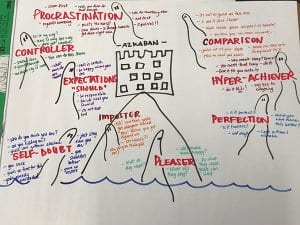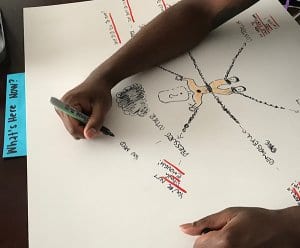A Picture is Worth 1,000 Words: The Art of Graphic Coaching
Coaching is a transformational experience that can dive deep into the mind, body and soul of a client. While some coaches encourage clients to feel the experience through embodiment, it is not always the most natural response for problem-solving. Coaches often end up working with the clients’ left-brain where logic, analysis and objective intellectual capital reside. I believe there is another way.
Through the use of graphic coaching, I take the mind and body connection a step further by using metaphor, visuals and rich depictions (both in the moment and in follow up notes) to tap into the creative, subjective and visual dimensions of coaching. It is here where we can deepen exploration, anchor concepts and tap into new and creative ways to help clients get unstuck.
Disclaimer: I am not a scientist or psychologist, nor am I an artist. I am a creative at heart who has a soft spot for the stationary aisle and sees a blank piece of paper as an invitation to play.
With graphic coaching, I have witnessed clients come alive, reflect on and connect to the images that we created. They dive deeper into finding meaning, resonance and impact. It’s amazing to see the “pause” that happens when an image lands with a client—that moment when the words, feelings and image align and they feel seen and heard.
So, how do I do it?
Mind Maps
Creating a mind map has allo wed my clients to see the big picture of their presenting issue. By using color coding, graphics and connector lines, we declutter what is in their minds to help gain clarity, direction and focus for our conversation.
wed my clients to see the big picture of their presenting issue. By using color coding, graphics and connector lines, we declutter what is in their minds to help gain clarity, direction and focus for our conversation.
To create a vision plan for a millennial client, I used a mind map that brought together the results of numerous assessments (e.g., MBTI, Emotional Intelligence, Strengths Finder, etc.), core values, desired feelings, passions and professional wants,. It was a powerful way to not only create a snapshot of who the client was but also what they saw for their future. It doubled as a blueprint with actionable steps to make incremental changes, which moved the client closer to his goals.
Coach Led Graphics
Coach led graphics (i.e., drawing in the moment) can help clients see their issue from a new vantage point. It gives the coach and client a chance to “co-create” in a way that is similar to perspective shifting approaches that allow clients to embody the conversation, but with a creative twist. 
I worked with a client who felt she was being held back by fear to make a major career transition. Embodiment for her was wearing a straightjacket. Graphically, it looked like being tethered to weights that prevented her from moving forward, no matter how hard she struggled. This depiction helped her see that there was not only restriction but also resistance. After we worked on naming the tethers (e.g., fear, judgment, failure, etc.), the conversation explored what might be possible with a pair of scissors and who she would become if she took a bold step forward.
Integrating coach led graphics allows me to send a follow-up email with images, quotes or visual cues/reminders to keep coaching top of mind and to prompt clients to continue doing the work between sessions. This can be as simple as offering a desktop background to remind a client of a concept or feeling they want to bring into their workspace.
Client Led Graphics 
Client led creativity is energizing, enlightening and often inspiring, especially in group settings. When clients have permission to think and do differently, they are keen to play along.
In a group activity, I asked clients to draw, in detail, their saboteur/inner critic as a metaphor—where it resides as well as what its climate, color and space is like. Resulting images include Harry Potter’s Azkaban circled by dementors; swamp creatures ready to pull individuals into the murky water; and a person suspended in mid air, extremities stretched in opposite directions by chains. We then explored the messages/phrases they heard most, and they added those to the image. Participants were then invited to reflect and share what they created as a way of externalizing those inner voices.
I’m amazed at how this simple exercise can powerfully shift the mood and energy in the room!
Graphic Coaching Tips
If you want to give graphic coaching a try, here are a few tips:
- Be in the moment
- Be creative—social media, quotes and popular culture hold powerful messages
- Depict the struggle and the opportunity
- Practice, get feedback, create your own style—there is no right or wrong way
- Celebrate victories
Don’t feel obligated to do it if it doesn’t add to the session, and don’t get stuck on your artistic ability.
Now, go get yourself some markers and play!



I love these ideas! Thank you for sharing them!! I’ve never tried creating graphics like this during a session, but I’m certainly inspired now that’s it’s in my toolkit.
Thanks Ashley. You had a role in inspiring me as well.
It was a great post.
Thanks
Thanks for sharing, I’m working also in that field. Good to know that we can share!!
Dear Susan, This is such a great post! I have been researching on sketch-notes as I find them very powerful in conveying messages. To see how visual coaching can get is inspiring! Thanks!
Hi Susan, thank you so much for your post. It is so inspirational, that in my monthly article to a Brazilian digital Coaching Magazine called Cloud Coaching, I will explore about this subject and really hope riders will enjoy it as much as i enjoyed yours.
Best,
João Luiz Pasqual
Sensacional! Inspiradora, lúdica e criativa demais com 1001 possibilidades! Gratidão em compartilhar conosco! Parabéns, Susan!
I LOVE THIS! Thanks so much for these ideas.
Very creative, Susan. When you realize that more than half the sensory neurons in our brains are visual, it makes wonderful sense to add visual modalities to coaching.
Ann V Deaton, PhD, PCC
Author, VUCA Tools for a VUCA World and Being Coached.
First of all thank you a lot for these ideas, they are out-of-the-box, fun, and I can’t wait to try them out ASAP. Also, I think some of us might be held back because of the myth about drawing. Even though high level art requires a lot of effort and talent, we are able to draw little cartoons pretty easily. A good example is in a Ted-talk from Graham Shaw with the title “Why people believe they can’t draw – and how to prove they can”.
Once again thank you for sharing this great idea, and keep being an awesome coach!